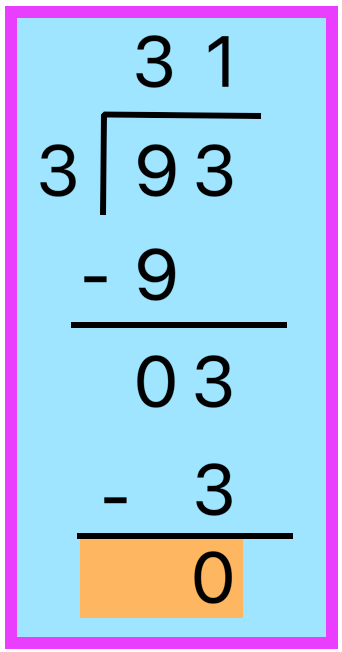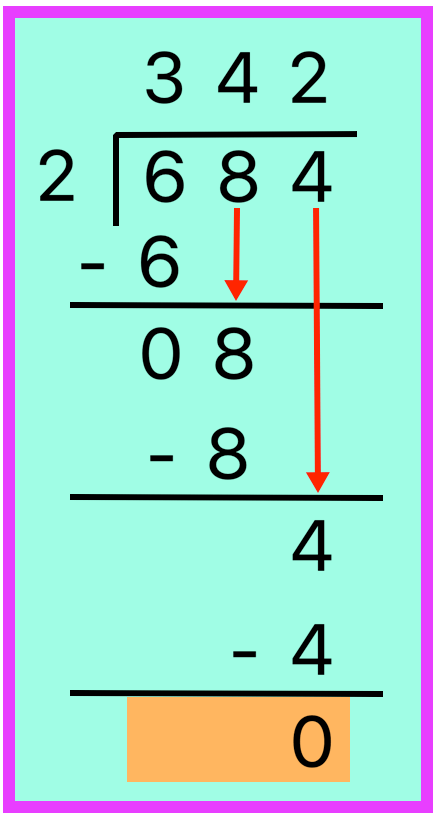Long Division Method without Regrouping and without Remainder
We will discuss here how to solve step-by-step the long division method without regrouping and without remainder.
Consider the following examples:
A. Dividing a 2-Digits Number by 1-Digit Number Without Regrouping and Without Remainder:
1. Divide 93 by 3
Step I.
First, arrange the number and divide 9 tens by 3.
We know that 3 × 3 = 9
So, we write 3 in tens place in the quotient.
Step II.
Write 9 (product of 3 and 3) in tens place below the dividend and subtract.
9 tens - 9 tens = 0
Now, 3 ones are left, we bring down 3 ones.
As, 3 × 1 = 3.
So, we write 1 in ones place in the quotient and 3 below the dividend in ones place.
Step III.
Subtract ones.
3 - 3 = 0,
We get 0 as the remainder.
Therefore, 93 ÷ 3 = 31
B. Dividing a 3-Digits Number by 1-Digit Number Without Regrouping and Without Remainder:
1. 848 ÷ 4
Let us follow the division along with the given steps.
|
Step I: Begin with hundreds digit
8 hundreds ÷ 4 = 2 hundreds Step II: Bring down tens digit
4 tens ÷ 4 = 1 ten Step III: Bring down ones digit 8 ones ÷ 4 = 2 ones |
Therefore, 848 ÷ 4 = 212
2. 6482 ÷ 2
Let us follow the division along with the given steps.
|
Step I: Begin with thousands digit 6 thousands ÷ 2 = 3 thousands
Step II: Bring down hundreds digit then 4 hundreds ÷ 2 = 2 hundreds Step III: Bring down tens digit 8 tens ÷ 2 = 4 tens Step IV: Bring down ones digit 2 ones ÷ 2 = 1 ones |
Therefore 6482 ÷ 2 = 3241
3. Divide 684 by 2.
Solution:
Step I: Arrange the numbers in proper columns.
Step II: Divide 6 hundreds by 2. (2 × 3 = 6)
Write 3 in hundreds place in the quotient.
Subtract the hundreds: 6 - 6 = 0
Step III: Divide 8 tens by 2. (2 × 4 = 8)
Write 4 in tens place in the quotient.
Subtract the tens 8 - 8 = 0
Step IV: Divide 4 ones by 2. (2 × 2 = 4)
Write 2 in ones place in the quotient.
Subtract the ones: 4 - 4 = 0
Therefore, 684 ÷ 2 = 342
Check:
342 × 2 = 684
So, the answer is correct.
From Long Division Method without Regrouping and without Remainder to HOME PAGE
Didn't find what you were looking for? Or want to know more information about Math Only Math. Use this Google Search to find what you need.
Recent Articles
-
Word Problems on Multiplication and Division of Fractions | Worksheet
Apr 13, 25 10:01 AM
Here we will solve different types of word problems on multiplication and division of fractions. I. Solve the following word problems on multiplication of fractions. -
One More than Numbers upto 10 | Counting One More | Learn 1 more Than
Apr 11, 25 04:09 PM
1 more than means we need to add or count one more number to the given numbers. Here, we will learn counting one more than upto number 10. Examples of counting 1 more than up to number 10 are given as… -
One Less than Numbers upto 10 | Counting One Less | Learn 1 Less Than
Apr 11, 25 04:07 PM
What is one less than? 1 less than means we need to subtract or count one less number of the given numbers. Here, we will learn counting one less than upto number 10. Examples of counting 1 less than… -
Properties of Multiplication and Division of Fractions Worksheet | Ans
Apr 10, 25 03:17 PM
In properties of multiplication and division of fractions worksheet you will get different types of questions based on properties of multiplication of fractional numbers and properties of division of… -
Word Problems on Fraction | Math Fraction Word Problems |Fraction Math
Apr 09, 25 01:44 AM
In word problems on fraction we will solve different types of problems on multiplication of fractional numbers and division of fractional numbers.







New! Comments
Have your say about what you just read! Leave me a comment in the box below. Ask a Question or Answer a Question.